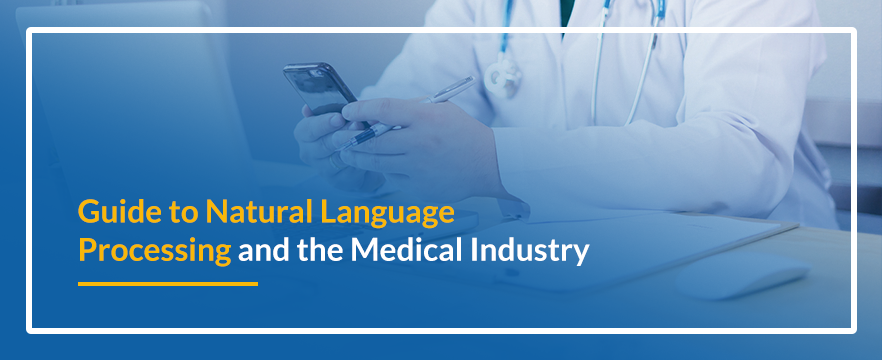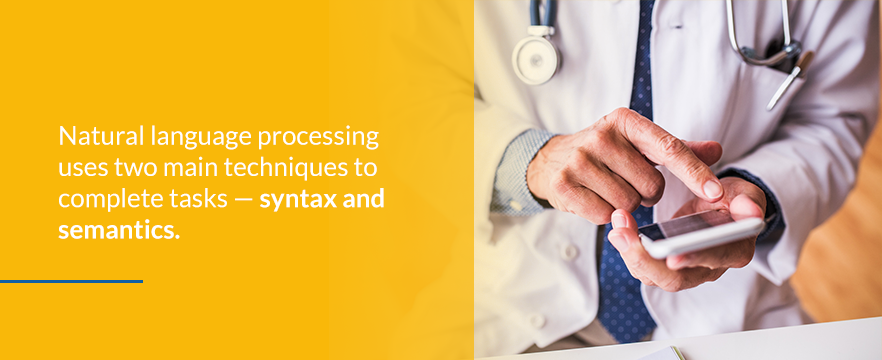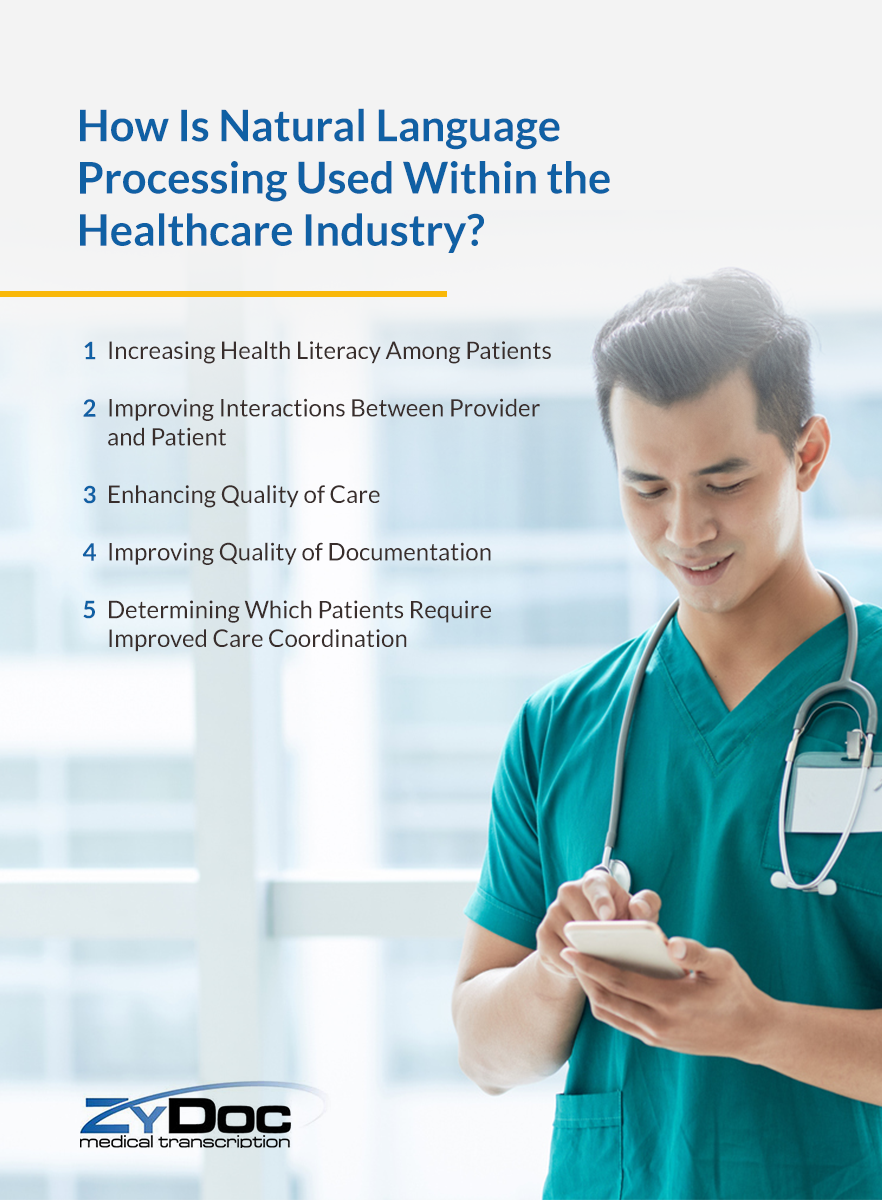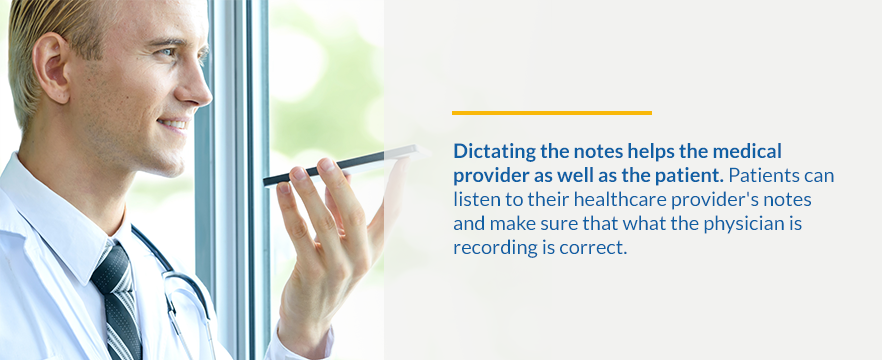Guide to Natural Language Processing and the Medical Industry
Mar 12, 2020 | Jonathan Maisel
Natural language processing is becoming increasingly popular in the medical industry. Why? Because natural language processing has the potential to interpret unstructured, complex datasets and to create actionable intelligence. By harnessing the potential and power of natural language processing, we can maximize an organization’s investment in capital, time and human efforts. Because huge volumes of data are churning out every day in the medical field, natural language processing is especially useful in this industry.
So what exactly is natural language processing? How is it used within the medical industry and outside the industry? We’ve compiled a guide to natural language processing to familiarize you with this processing form that is soaring in the healthcare industry.
What Is Natural Language Processing?
Natural language processing is an artificial intelligence technology that helps computers understand the natural language of humans. The goal is to teach machines how we communicate so they can understand language the way we do — not an easy task.
With natural language processing, our technology can read, understand and decipher human languages in a valuable way. Natural language processing works through the application of algorithms for identifying and extracting rules of natural language. Following this process, the data from the natural language is then converted into a form that can be understood by computers.
Essentially, by using algorithms, computers extract essential data from every sentence to understand the human’s input and formulate a response.
Using natural language processing, an interaction between a machine and a person could go like this:
- The person speaks to the machine.
- The device captures the audio.
- A conversion between audio to text occurs.
- The machine processes the data of the text.
- A conversion between the data to audio occurs.
- The device responds to the person with an audio file.
Because of the nature of human language, natural language processing can be difficult. Rules of exchanging information via natural language aren’t easy for machines to learn or understand. Whereas learning a language may seem easy to us, ambiguity and inconsistency in our natural language make it difficult for machines to master.
A machine needs to understand the words — which can be difficult with the English language, as our words can have multiple meanings — and it also needs to understand how the concepts of a message are connected. Throw in people using sarcastic remarks when communicating with their devices and it’s no wonder natural language processing can be such a challenging technology to implement. However, the benefits of using natural language processing are well worth the effort.

How Is Natural Language Processing Used Outside of the Healthcare Industry?
Natural language processing uses two main techniques to complete tasks — syntax and semantics. How are semantic analysis and syntactic analysis used in natural language processing? What are the uses of natural language processing outside of the healthcare industry?
1. Use of Syntax in Natural Language Processing
First, what is syntax? Syntax is how the words are arranged within a sentence to make the most sense grammatically. Natural language processing uses syntactic analysis to compare the natural language with grammatical rules. Algorithms apply grammatical rules to words so that the computer can extract meaning from the words.
The following are some of the syntax techniques a computer might use in natural language processing:
- Word segmentation: This technique works by breaking apart a large amount of continuous text into units.
- Stemming: In this technique, inflected words are cut to their root forms.
- Sentence breaking: This technique works by implementing boundaries on sentences in a lengthy chunk of text.
- Parsing: In this technique, the sentence is analyzed grammatically.
- Part-of-speech tagging: In this technique, the part of speech of each word is identified.
- Morphological segmentation: This technique works by splitting words into individual units known as morphemes.
When a user’s natural language doesn’t align with grammatical rules, this can make understanding what a user is saying difficult for the computer. Fortunately, syntactic analysis is not the only technique used in natural language processing.
2. Use of Semantics in Natural Language Processing
What is semantics? Semantics is the meaning a text conveys. This is one of natural language processing’s challenging aspects and is yet to be entirely resolved.
In semantic analysis, computer algorithms are applied to text to interpret and understand the meaning of the words and to understand how the sentences are constructed.
The following are some of the semantics analysis techniques a computer might use in natural language processing:
- Natural language generation: In natural language generation, databases are used to derive semantic intentions. These are then converted into human language.
- Named entity recognition: Named entity recognition involves determining which parts in a text can be categorized in preset groups, such as names of places or names of people.
- Word sense disambiguation: Word sense disambiguation involves using context to apply meaning to each word.
Semantics can be a more difficult aspect of natural language processing than syntax, as interpreting meaning is more challenging than aligning text with grammatical rules.
3. Uses of Natural Language Processing Outside of the Healthcare Industry
Where can you find natural language processing outside of the healthcare industry? Think technology like Siri, Cortana, Alexa and Google Home. These intelligent assistants use natural language processing to understand and respond to your commands and questions. Natural language processing is also behind:
- Grammarly
- Google Translate
- Microsoft Word
- Call centers’ interactive voice response applications
Natural language processing has become such an integral part of our technology that many of us don’t even realize we’re using natural language processing daily through nearly all of our devices, including our phones, tablets and laptops.

How Is Natural Language Processing Used Within the Healthcare Industry?
Today, natural language processing is being used to enhance the delivery of care in the healthcare industry. Natural language processing algorithms are quickly proving to be valuable in the medical industry, enabling dictation for voice-to-text and simplifying clinical documentation. As IT tools in the healthcare field grow more advanced, the potential for the role of natural language processing in healthcare will only continue to increase.
What are some of the uses of natural language processing in the healthcare industry today?
1. Increasing Health Literacy Among Patients
Natural language processing tools may also create smoother interactions between health IT tools and patients. Patient portals are growing increasingly common in healthcare organizations, allowing patients to access data related to their health, maintain their health and improve their ability to make informed health-related decisions.
The benefits of these patient portals are lost, though, if patients can’t interpret the data. If patients can’t understand what their data means, they can’t use this information to make more informed decisions about their medical care.
The lack of patient health literacy negatively affect patients, but it also negatively impacts physicians. Physicians need to sacrifice more of their time to explain terms to patients and soothe their worries when they misread a lab test result or diagnosis.
Healthcare organizations can improve their patients’ understanding of medical information by integrating natural language processing into patient portals. Natural language processing tools can match medical terms with lay-language to make clinical documents easier for patients to understand. These tools can also link simple definitions with medical terms.
2. Improving Interactions Between Provider and Patient
Natural language processing can help providers improve their interactions with patients. Medical professionals can quickly become drained under the burdens of completing all documentation requirements and attempting to give their undivided attention to their patients.
This issue is so huge it’s become an epidemic in the healthcare field. Physician burnout can have a significant negative impact on an organization. To combat this problem, organizations seek ways to minimize physician burnout related to electronic health records.
This is where natural language processing comes in. Tools like voice recognition can help alleviate the distress of electronic health records (EHR) for clinicians. Voice recognition is an incredibly helpful, convenient alternative to handwriting or typing notes about a patient.
Dictating the notes helps the medical provider as well as the patient. Patients can listen to their healthcare provider’s notes and make sure that what the physician is recording is correct. This method allows for a collaborative effort between physician and patient that makes the process more efficient and accurate.
A physician can also provide the information to the patient at the same time that it’s being recorded, allowing medical professionals to save time and dedicate more of their attention and time to their patients.
3. Enhancing Quality of Care
The quality of medical care can also be enhanced by natural language processing tools. Through the use of these tools, evaluating the quality of care becomes easier. For organizations to ensure efficiency and competency, they measure the performance of their physicians and identify gaps in care.
Natural language processing automates the evaluation of text and reduces the time and effort required of staff to complete an assessment of physicians’ professional skills. Algorithms in natural language processing can help medical professionals identify possible mistakes in care delivery, including the identification of adverse drug events. Natural language processing can also assist in monitoring how well an organization adheres to clinical guidelines and in assessing inpatient care quality.
Compared to manual data extraction, healthcare natural language processing tools perform more effectively in terms of precision and efficiency.
4. Improving Quality of Documentation
Natural language processing in healthcare can also improve the quality of physician documentation. Physicians won’t need to hastily scribble down illegible notes that neither they nor anyone else can decipher later. Instead, physicians can use voice dictation tools to record their notes. Physicians also won’t have to worry about forgetting something in the time between speaking with their patients and being able to put their notes down on paper or typing them into a computer.
Higher quality documentation can be useful for analytics later on. We may even get to the point that these tools go beyond simple dictation and progress to receiving and carrying out directions. Virtual assistants like Cortana, Alexa and Siri are used in organizations to service help desks and assist in customer service tasks.
As our technology continues to develop, we may see these tools going beyond the administrative side and entering the clinical side of the field.
5. Determining Which Patients Require Improved Care Coordination
How can clinicians quickly and effectively determine which of their patients might be at a higher risk for social, behavioral and psychological effects on their wellbeing and health?
Through the use of natural language processing tools, organizations can determine which complex patients may need improved care coordination. Factors like food insecurity and housing instability make sticking to treatment protocols more difficult for patients. These factors may also contribute to these patients incurring more costs for care, such as if these factors lead to substance abuse or mental health issues.
Accessing social determinants of health is more difficult than a patient’s clinical information, and this is where natural language processing can provide a solution. Natural language processing tools can extract information from a large set of data and provide this information to clinicians so they can identify complex patients.
With medical natural language processing, clinicians can determine which patients may need enhanced care coordination for behavioral health issues.
Natural language processing provides multiple benefits and conveniences to the healthcare industry, including improving patient health outcomes and increasing the effectiveness of clinical decisions.

What Processes Are Being Developed in the Healthcare Industry Thanks to Natural Language Processing?
Because of natural language processing, a few processes are being developed to improve the healthcare industry.
- Cognitive computing: The human mind has a limited cognitive capacity, and natural language processing could assist in cognitive computing in the healthcare industry.
- Big data analytics: The healthcare industry consistently churns out an overwhelming amount of data. Natural language processing can make extracting and utilizing data much more efficient.
- Precise medicine applications: Natural language processing may be able to assist physicians in determining the right medicine to prescribe to a patient.
- Coding: Natural language processing may also be able to handle coding claims for billing and reimbursement.
- User interfaces: The medical data displayed in a user interface can become more accessible to patients through the use of natural language processing.
The healthcare industry relies heavily on technology, and health tech is expected to top $10 trillion in just a few years. Natural language processing is likely to contribute dramatically to the efficiency and effectiveness of this industry in the future.

Find Medical Documentation Services at ZyDoc
At ZyDoc, our clients can easily create, manage and share clinical documentation, including referral letters and patient notes. Dictate your notes on the go with SpeechDocTM to securely turn your recordings into text-based documents. Start using our medical transcription services at ZyDoc today.
